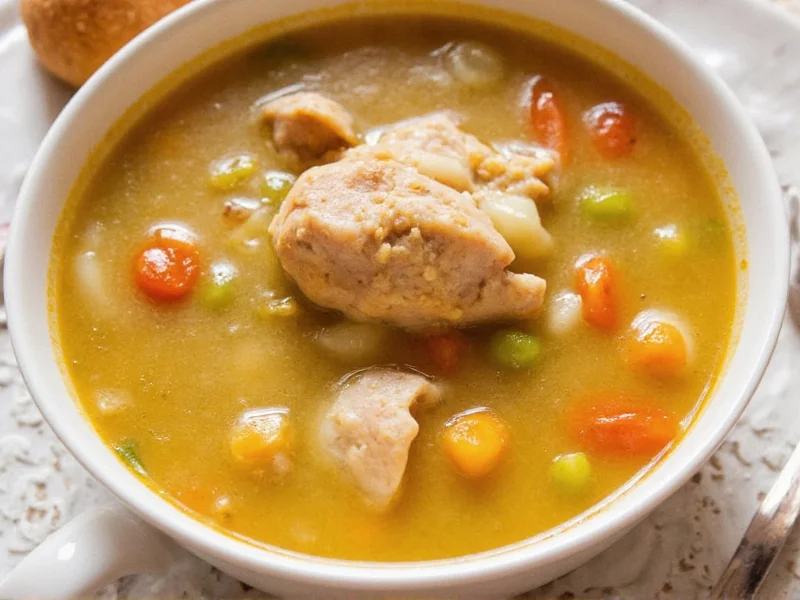Why Chicken Thighs Excel in Soup Making
Chicken thighs contain more fat and collagen than breasts, which transforms into gelatin during cooking, naturally thickening your broth and adding luxurious mouthfeel. The dark meat stays moist even with extended simmering—unlike breasts that often turn dry and stringy. Bone-in thighs contribute additional depth of flavor as marrow and connective tissues dissolve into the broth. Professional chefs consistently choose thighs for soup bases because they create more complex, satisfying results with minimal effort.
Essential Components for Perfect Chicken Thigh Soup
Creating exceptional chicken thigh soup requires attention to three critical elements: the chicken preparation, aromatic foundation, and vegetable selection. Start with bone-in, skin-on thighs for maximum flavor extraction. For the aromatic base, use the classic mirepoix ratio of 2 parts onion, 1 part carrot, and 1 part celery. Fresh garlic and herbs like thyme or rosemary add complexity. Choose vegetables that maintain texture during cooking—potatoes, parsnips, or turnips work better than delicate options that disintegrate.
| Cooking Method | Time | Temperature | Result |
|---|---|---|---|
| Simmering bone-in thighs | 30-40 minutes | 180-200°F (82-93°C) | Tender meat, rich broth |
| Simmering boneless thighs | 20-25 minutes | 180-200°F (82-93°C) | Perfectly cooked, not dry |
| Pressure cooking | 12-15 minutes | High pressure | Intense flavor, fall-apart texture |
Step-by-Step Chicken Thigh Soup Preparation
Follow this professional technique for foolproof chicken thigh soup. First, brown thighs skin-side down in olive oil for 5-7 minutes until golden—this Maillard reaction creates foundational flavor. Remove and set aside. Sauté onions, carrots, and celery for 8-10 minutes until softened. Add garlic and cook 1 minute more. Return chicken to pot, cover with 6-8 cups quality broth, and add 2 bay leaves. Simmer uncovered for 30-40 minutes for bone-in thighs (20-25 for boneless). Remove chicken, shred meat, discard skin and bones, then return meat to pot. Add diced vegetables and simmer 15-20 minutes until tender. Finish with fresh herbs and a splash of acid like lemon juice or vinegar to brighten flavors.
Variations for Every Palate
Create diverse chicken thigh soup experiences by adjusting ingredients and techniques. For creamy chicken thigh soup, add 1 cup coconut milk or heavy cream during the last 10 minutes of cooking. Transform your base into chicken and dumplings by dropping biscuit dough on top during the final simmer. Make it Asian-inspired with ginger, soy sauce, and rice noodles. For a hearty chicken thigh soup with vegetables, add hearty root vegetables early and delicate greens like spinach at the end. Try a Mexican-style version with black beans, corn, and chipotle peppers. Each variation maintains the rich foundation provided by the chicken thighs while offering distinct flavor profiles.
Avoiding Common Chicken Soup Mistakes
Prevent disappointing results by avoiding these frequent errors. Never boil soup vigorously—maintain a gentle simmer to prevent meat from becoming tough. Don't add salt too early; season in stages, finishing with final adjustments after reducing. Avoid overcooking vegetables—add them according to their required cooking times. Don't discard the collagen-rich liquid when shredding chicken; this contains valuable flavor. Resist adding too many competing flavors that mask the chicken's natural richness. For clear broth, skim fat regularly during cooking rather than at the end. Properly stored leftovers actually improve in flavor after 24 hours as ingredients meld.
Storage and Reheating Best Practices
Chicken thigh soup stores exceptionally well due to the fat content preserving moisture. Cool completely before transferring to airtight containers. Refrigerate for up to 4 days or freeze for 3 months. When reheating, do so gently over medium-low heat to prevent separation. If freezing, leave 1-inch headspace for expansion. For cream-based soups, stir frequently while reheating and consider adding a splash of broth if texture thickens too much. The collagen in thigh-based soups may cause them to gel when cold—this is normal and liquefies upon reheating, indicating excellent broth quality.
Frequently Asked Questions
Can I use boneless chicken thighs for soup?
Yes, boneless chicken thighs work well for soup but require less cooking time (20-25 minutes) compared to bone-in. While they produce slightly less complex broth, they're convenient and still yield tender, flavorful results. For best flavor, consider adding a chicken bone or two to the pot when using boneless thighs.
Why does my chicken thigh soup taste bland?
Bland chicken thigh soup typically results from insufficient seasoning layers. Season at multiple stages: lightly salt chicken before browning, season vegetables while sautéing, and finish with final adjustments after cooking. Acidic elements like lemon juice or vinegar added at the end also brighten flavors. Using homemade broth instead of store-bought significantly enhances depth.
How do I prevent chicken thighs from becoming rubbery in soup?
To prevent rubbery texture, avoid boiling the soup vigorously—maintain a gentle simmer. Remove thighs when internal temperature reaches 165°F (74°C) and let residual heat bring them to 175°F (80°C). Overcooking is the primary cause of toughness. Bone-in thighs are more forgiving than boneless, providing a larger temperature window for perfect tenderness.
What vegetables hold up best in chicken thigh soup?
Hardy vegetables like potatoes, sweet potatoes, parsnips, turnips, and carrots maintain their structure during extended cooking. Add these at the beginning with the broth. Softer vegetables like zucchini, green beans, and peas should be added in the last 10-15 minutes. Leafy greens like spinach or kale work best when stirred in during the final 5 minutes of cooking.











 浙公网安备
33010002000092号
浙公网安备
33010002000092号 浙B2-20120091-4
浙B2-20120091-4